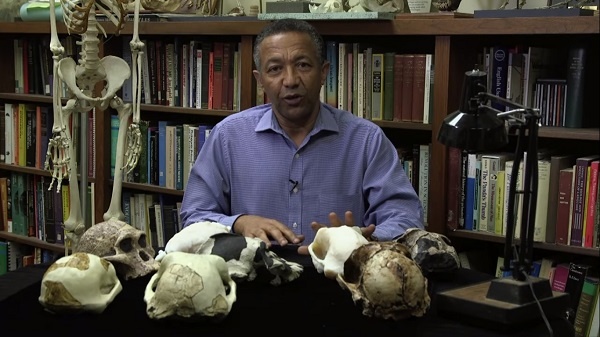
Dr. Yohannes Haile-Selassie, the Cleveland Museum of Natural History’s Curator of Physical Anthropology, discovered a “remarkably complete” hominin cranium at Woranso-Mille Research Site in Ethiopia.
CLEVELAND, OH (Cleveland Museum of Natural History) – Cleveland Museum of Natural History Curator of Physical Anthropology Dr. Yohannes Haile-Selassie and his team of researchers have discovered a “remarkably complete” cranium of a 3.8-million-year-old Australopithecus anamensis specimen. This discovery has led to the disproval of a commonly accepted hypothesis about the evolution of hominins, a taxonomic tribe of primates that includes modern humans and their evolutionary ancestors.
The team of experts, led by Yohannes*, has diligently worked at the Woranso-Mille research site in Ethiopia since 2004. It was here, in the Miro Dora locality, that the team discovered the specimen MRD-VP-1/1, referred to as “MRD,” on February 10, 2016.
The first piece of the specimen—the upper jaw—was found by a local Afar worker, Ali Bereino. As the team searched for more fragments, Yohannes had a strong intuition that this would turn out to be a significant discovery.
“Ethiopia has always been labeled as the cradle of humankind, especially in the Afar region, where we have 6 million years of our evolutionary history packed in this 1-kilometer thick sediment,” he says.
At the Woranso-Mille research site alone, approximately 12,600 fossil specimens—including 230 hominin fossils—have been discovered. What’s more, the team was working a mere 35 miles away from Hadar, the region in which the famous “Lucy” specimen, of the Australopithecus afarensis taxon, was found. But despite this knowledge, Yohannes couldn’t fathom the discovery he was about to make.
Upon arrival at the location of the jaw discovery, Yohannes saw something globular less than ten feet away from where he was standing. Getting closer, he realized that it was a tiny braincase and hoped that it would fit with the jaw. He picked it up and sure enough, the two pieces seamlessly clicked together like puzzle pieces.
“I couldn’t believe my eyes when I spotted the rest of the cranium,” Yohannes says of this incredibly rare find. “It was a eureka moment and a dream come true.”
In the years following this discovery, the team conducted extensive analyses of MRD. The peer-reviewed results of these analyses have recently been published in the international scientific journal Nature, with Yohannes credited as the lead researcher.
Among the most significant findings was the team’s conclusion that A. anamensis and its descendant species, the well-known A. afarensis, coexisted for a period of at least 100,000 years. This finding contradicts the long-held notion of anagenesis in hominins, whereby one species disappears and gives rise to the next in a linear fashion.
“This is a game changer in our understanding of human evolution during the Pliocene,” says Yohannes.
Read the complete story at Cleveland Museum of Natural History
* Ethiopians use patronymic names rather than family names. That is, a person in Ethiopia is addressed by his/her given name as there is no such thing as ‘family name’ or ‘inherited name.’
